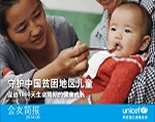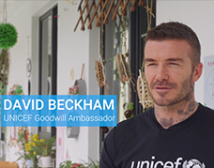NEW YORK, 9 December 2016 – An estimated 535 million children – nearly one in four – live in countries affected by conflict or disaster, often without access to medical care, quality education, proper nutrition and protection, UNICEF said today.
Sub-Saharan Africa is home to nearly three-quarters – 393 million – of the global number of children living in countries affected by emergencies, followed by the Middle East and North Africa where 12 per cent of these children reside.
The new figures are released as UNICEF, on Sunday 11 December 2016, marks 70 years of relentless work in the world's toughest places to bring life-saving aid, long-term support, and hope to children whose lives and futures are threatened by conflict, crises, poverty, inequality and discrimination.
“UNICEF was established to bring help and hope to children whose lives and futures are endangered by conflict and deprivation, and this enormous figure – representing the individual lives of half a billion children – is a sharp reminder that our mission is becoming more urgent every day,” said UNICEF Executive Director Anthony Lake.
The impact of conflict, natural disasters and climate change is forcing children to flee their homes, trapping them behind conflict lines, and putting them at risk of disease, violence and exploitation.
-
Nearly 50 million children have been uprooted – more than half of them driven from their homes by conflicts.
-
As violence continues to escalate across Syria, the number of children living under siege has doubled in less than one year. Nearly 500,000 children now live in 16 besieged areas across the country, almost completely cut off from sustained humanitarian aid and basic services.
-
In northeastern Nigeria, nearly 1.8 million people are displaced, almost 1 million of them are children.
-
In Afghanistan, nearly half of primary-aged children are out of school.
-
In Yemen, nearly 10 million children are affected by the conflict.
-
In South Sudan, 59 per cent of primary-aged children are out of school and 1 in 3 schools is closed in conflict affected areas.
-
More than two months after Hurricane Matthew hit Haiti, more than 90,000 children under five remain in need of assistance.
The emergencies faced today by the most vulnerable children threaten to undermine immense progress made in recent decades: Since 1990, the number of children dying before their fifth birthday halved and hundreds of millions of children have been lifted out of poverty. Out-of-school rates among primary-school-aged children have reduced by more than 40 per cent between 1990 and 2014.
Despite significant progress, too many children are being left behind because of their gender, race, religion, ethnic group or disability; because they live in poverty or in hard-to-reach communities; or simply because they are children.
“Whether children live in a country in conflict or a country in peace, their development is critical not only to their individual futures but also to the future of their societies,” said Lake.
###
Notes to Editors:
Please note that the figures refer to the number of children living in countries affected by conflict, crisis and disaster. The figures have been calculated by using population data for countries where UNICEF has a humanitarian appeal.
For further information, please contact:
Georgina Thompson, UNICEF New York, Tel: +1 917 238 1559, gthompson@unicef.org
Melanie Sharpe, UNICEF New York, Tel: +1+1 917 251 7670, msharpe@unicef.org
UNICEF by numbers
Nutrition
In the 1940s, UNICEF began providing emergency nutrition aid, mainly in the form of milk, to children in post-World War II Europe. In 2015, UNICEF and partners worldwide treated 2.9 million children for severe acute malnutrition.
Health
In the 1950s, UNICEF's first immunization campaigns targeted diseases such as tuberculosis and yaws. In 2015, UNICEF procured 2.8 billion doses of vaccines, helping to protect 45 per cent of the world's children under age 5 from deadly diseases.
In 1998, UNICEF became a founding member of the Roll Back Malaria Partnership to support malaria treatment and research, and expand prevention measures such as long-lasting insecticide-treated bed nets. In 2015, UNICEF procured 22.3 million bed nets to protect children and families in 30 countries.
Education
In 1961, UNICEF expanded its programmatic focus to include children's education. In 2015, UNICEF provided 7.5 million children aged 3 to 18 with access to formal or non-formal basic education.
Child protection
In 1989, the United Nations General Assembly adopted the Convention on the Rights of the Child, which specifies that all children should be registered at birth to establish their existence under the law and safeguard many of their rights. In 2015, more than 9.7 million births were registered in 54 countries with support from UNICEF.
Water, sanitation and hygiene
In 1953, UNICEF launched its first efforts to improve access to water, sanitation and hygiene for children and families in need, and it has expanded that work with many partners over time. Between 1990 and 2015, 2.6 billion people gained access to improved drinking water sources and 2.1 billion gained access to improved sanitation facilities.
Humanitarian action
Since its founding, UNICEF has never stopped responding to humanitarian emergencies affecting children – particularly those already burdened by poverty and disadvantage.
In 2015, UNICEF and partners:
• Vaccinated 11.3 million children against measles in countries affected by crisis.
• Provided 4 million children in emergency situations with access to formal or non-formal basic education.
• Provided psychosocial support for 2 million children caught in conflicts and natural disasters.
General Comparative Facts
In 1955, UNICEF was assisting 92 countries and territories. In 2016, UNICEF works in 190 countries and territories.
The first National Committee for UNICEF was formed in the United States in 1947 to raise funds and awareness on the agency's behalf. In 2016, there are 34 National Committees around the world.
In 1972, UNICEF employed about 1,000 international and locally recruited staff members. In 2016, it has a global staff of approximately 13,000.
About UNICEF
UNICEF promotes the rights and wellbeing of every child, in everything we do. Together with our partners, we work in 190 countries and territories to translate that commitment into practical action, focusing special effort on reaching the most vulnerable and excluded children, to the benefit of all children, everywhere.
For more information about UNICEF and its work visit: www.unicef.org































